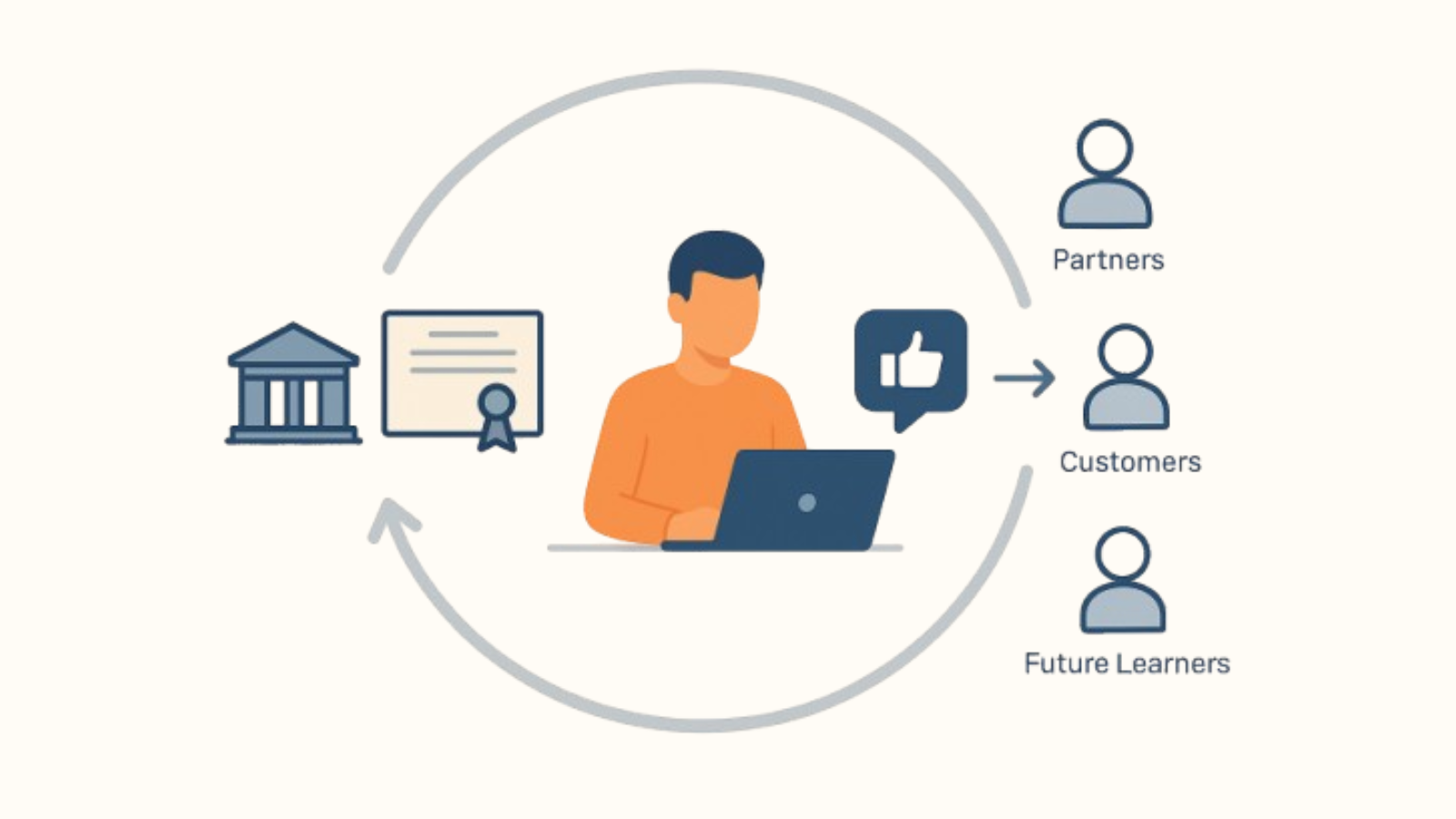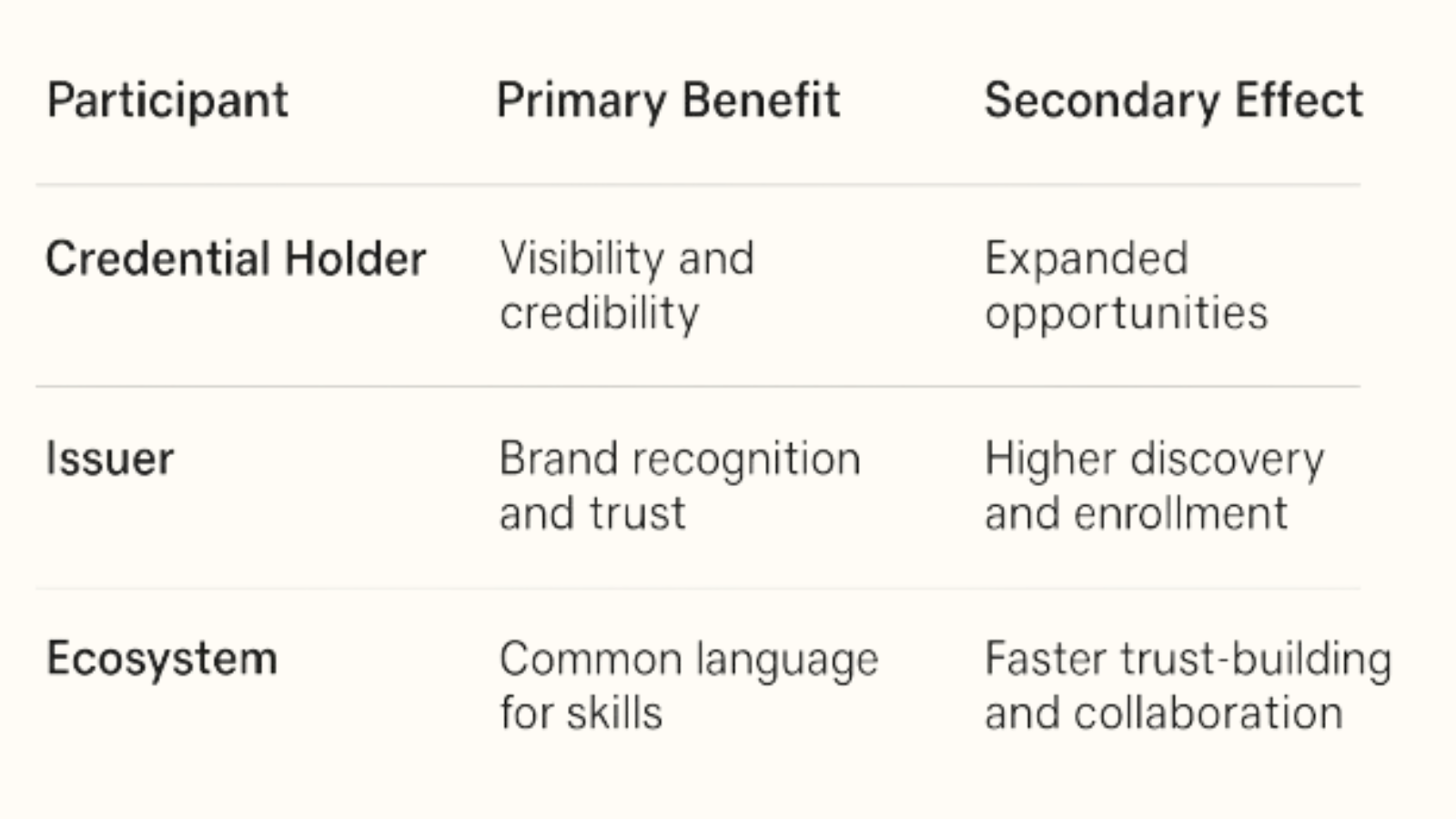In a landscape where knowledge moves quickly and credibility is increasingly visible, the way we acknowledge learning has become far more than administrative formality. Certificates are not just evidence of completion. They are identity signals: markers of skill, alignment, and professional association. Yet the traditional certificate format has remained largely unchanged, static both in form and effect.
Hyperstack uses the term Mindshare Loop to describe the moment when a digital credential does something a paper certificate never could. Instead of concluding the learning experience, a digital credential initiates a continuous cycle of visibility and recognition. It travels. It is shared. It is seen. It shapes perception in multiple contexts. And it continues to generate value long after the moment of issuance.
What results is a reinforcing loop of identity and brand presence:
- The credential holder strengthens their professional visibility.
- The issuer expands reach and credibility with every share.
- The ecosystem gains clearer language and trust around demonstrated skill.
A digital credential becomes a trusted signal in motion, where a paper certificate simply stays still.
The Static Outcome of the Traditional Certificate
A traditional certificate serves a single function: proof of completion. After that, it becomes dormant. It sits in email archives, storage folders, or printed frames. If verification is needed, it is manual. If visibility is needed, it depends entirely on the individual remembering to upload it somewhere as an image or PDF.
There is no interactive element.
No renewing cycle of relevance.
No ability for the issuer’s credibility to move beyond the moment of issuance.
Traditional certificates record value.
They rarely extend it.
Digital Credentials Introduce Mobility and Presence
A digital credential is not an image of achievement. It is a structured, portable identity layer. It contains context, verification, metadata, and narrative. It connects to platforms where professionals build reputation.
Most importantly, it is designed to circulate.
When attached to a profile, shared to a network, or displayed in a portfolio, it speaks for both parties:
- The individual is recognized for mastery.
- The organization is recognized for shaping it.
This is shared identity signaling, and it is the foundation of the Mindshare Loop.
How the Mindshare Loop Emerges
 Issuance as the Starting Point
Issuance as the Starting Point
A verified digital credential is awarded. This is not the end of the learning process; it is the beginning of its visibility.
A moment of infinite potential.
Circulation Driven by Personal Value
The learner displays the credential because it helps them communicate competence, qualification, and belonging. No prompting from the issuer is needed.
Digital credentialing platforms like Hyperstack integrate freely with dozens of social media platforms like LinkedIn. Also on offer is a robust API support allowing synchronization with multiple LMS, HR platforms, CRMs, and more.
Network Interpretation and Response
Others encounter the credential. They notice the skill associated with it. They recognize the issuer. They connect credibility to both.
The cycle strengthens itself, without additional effort from the issuing organization.
This is the self-replicating loop.
The Reputation Singularity
At a certain point, a well-circulated credential stops functioning as a simple record of achievement. It becomes an independent signal. The Mindshare Loop initiates this shift. A credential is issued, shared, recognized, and reshared within networks of aligned interest. With each repetition of this cycle, something more defined begins to form. The credential no longer depends on the issuer’s active promotion to validate its relevance or quality. It begins to create credibility on its own.
This moment is what we call The Reputation Singularity.
This is the point at which:
- The credential carries its own identity or weight in the ecosystem.
- The issuer’s brand is recognized without being reintroduced.
- The holder’s achievement is understood immediately, even without supporting explanation.
Traditional certificates require the audience to already trust the issuing institution. Digital credentials, once engaged in the Mindshare Loop, gather social proof and network validation as they move. Each instance of sharing, endorsement, application, or reference contributes to their authority and context.
Gradually, the credential transitions from:
- Proof, to signal
- Signal, to recognition
- Recognition, to value
At this stage, the credential functions as brand equity in motion, rather than a one-time document.
How The Mindshare Loop Builds ROI
Issuer Benefits
- Every credential becomes a persistent advertisement for the learning experience.
- Brand awareness grows through genuine learner networks instead of marketing spend.
- Enrollment and discovery accelerate as recognition increases across the ecosystem.
Credential Holder Benefits
- Their achievements are recognized more quickly and with less explanation.
- The credential actively works in their favor, even when they are not presenting it.
- Opportunities expand because the credential has become its own reference point.
Ecosystem Benefits
- Communities gain a common, recognizable language for skills.
- Collaboration and trust form faster because competence is easier to verify.
ROI here is not incremental. It compounds over time.
Each new credential:
- Strengthens the perceived value of previous ones
- Makes the learning program easier to trust and easier to choose
- Reduces the need for costly messaging or repeated marketing effort
The credential continues generating awareness, credibility, and professional mobility long after the learner completes the course. It becomes a steady, self-sustaining signal that supports holder and issuer alike.
This is the Mindshare Loop in practice.
Why This Cycle Has Impact
People communicate identity through what they choose to display. A credential is not only a record of skill; it is a signal of who someone has chosen to learn from and align with.
This leads to:
- Recognition (others understand what the person is capable of)
- Social Proof (multiple individuals displaying the same credential creates perceived standard)
- Belonging (the credential signals membership in a community of practice)
- Momentum (each new instance of display increases perceived significance)
What begins as a single recognition event becomes a shared, lived narrative. Every participant leads to different outcome; thereby boosting opportunities, discovery and quicker trust-building and collaboration.

No party’s value comes at the expense of another.
Each benefits because the credential continues to be seen.
This is mutual growth, reinforced through shared identity.
Credentials as a Strategic Growth Asset
Organizations often ask where the measurable return lies.
It lies in:
- Persistent brand presence in professional contexts
- Organic discovery as credentials circulate across networks
- Reduced friction in verification and trust-building
- Natural continuation of learner engagement when credentials stack as pathways
Digital credentials convert certificate issuance from a one-time administrative action into a continuous influence mechanism.
The return is not one-dimensional.
It compounds.
It builds reputation that moves.
Why This Evolution is Emerging Now
Three forces accelerate the relevance of digital credentials:
- Professional identity is now digitally expressed and visible.
- Skills are increasingly evaluated independently of degrees.
- Distributed and remote work environments require portable credibility.
The environment has changed.
Recognition must match the environment to remain meaningful.
Design as Behavior, Not Decoration
A digital credential is intentionally designed to be displayed. Its clarity, structure, and aesthetic play a role in whether a learner chooses to share it.
This is not cosmetic preference.
This is behavioral design.
Visibility is achieved when a credential feels:
- Presentable
- Modern
- Representative of identity
When it feels worth showing, it is shown.
When it is shown, the loop continues.
A Loop That Strengthens Over Time
- A learner completes a course.
- They receive a digital credential.
- They display it online.
- Peers see it and form impressions.
- Some explore or enroll.
- They earn their own credentials.
- The network grows, and the signal amplifies.
This isn’t linear, it compounds exponentially.
The credential keeps shaping how it’s perceived, long after issuance.
Final Thoughts
The Mindshare Loop reframes the purpose and potential of credentials. Instead of marking a moment that has passed, digital credentials continue to shape identity and professional alignment long after they are awarded. They strengthen both the individual and the Institution, because they are designed to bounce within the walls of education and employers.
A credential is no longer a static record.
It is a living signal, circulating in highly relevant networks where actual credibility is instantly recognized.
Where traditional certificates conclude a journey, digital credentials continue it.
The loop does not end, it extends. To infinity.
A Quick Word Before You Go
The Mindshare Loop and the Reputation Singularity are not theoretical ideas. They are recurring outcomes that we noticed emerging when credentials are designed well enough to move, interact, and stay relevant. If your learning program is ready to grow beyond one-time recognition and into sustained, compounding visibility; Hyperstack is here to help you make that transition with clarity and intention.
Explore what this could look like for your learners or your institution.
Schedule a free demo today!
Frequently Asked Questions
1.What is the Mindshare Loop?
The Mindshare Loop is a concept introduced by Hyperstack to describe how a digital credential continues to generate awareness, value, and recognition long after it is issued. Once shared and circulated in relevant networks, the credential forms a feedback cycle that benefits the credential holder, the issuer, and the broader ecosystem at the same time.
2.How is the Mindshare Loop different from traditional certificate sharing?
Traditional certificates tend to create a single moment of acknowledgment. Their visibility fades once the initial announcement passes. The Mindshare Loop, on the other hand, keeps the credential active as a living signal. It circulates through digital platforms, professional communities, and skill networks, consistently reinforcing credibility and recognition.
3.What is the Reputation Singularity?
The Reputation Singularity is the point at which a credential begins to reinforce its own value without needing additional validation from the issuer. At this stage, its recognition is understood immediately within the ecosystem. The credential, in effect, “credits itself” and becomes a trusted signal of competence and association.
4.How does the Mindshare Loop improve ROI for issuers?
Every credential issued becomes a long-term visibility asset for the organization. Instead of relying solely on paid marketing or frequent outreach, the issuer gains continuous brand exposure through participant networks. This leads to greater trust, higher discovery, and more organic enrollment over time.
5.How does the Mindshare Loop benefit learners?
Learners receive more than proof of completion. They gain a credential that actively supports their professional identity. It strengthens personal branding, improves discoverability across networks, and expands opportunities in both open and closed professional communities.
6.How does the ecosystem benefit?
As more credentials circulate, the ecosystem gains a shared language for recognizing skills. This reduces friction in collaboration, hiring, verification, and trust-building. The result is faster decision-making and clearer alignment between skill demand and capability supply.
Do these effects compound over time?
Yes. The value of each credential contributes to the visibility of all other credentials connected to the issuer. Growth happens through repeated interactions over time rather than one-time announcements. The result is compounding equity for both individuals and institutions alike.